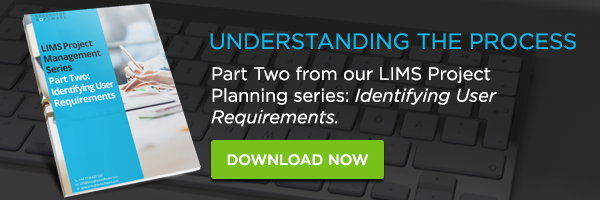
Looking for the right LIMS for your laboratory can take up a lot of time. As a bare minimum, you’ll need a clear understanding of your requirements and arrange demonstrations, so you can get a feel for what the LIMS can deliver for your lab. In this blog, we highlight some of the key areas to consider when you are selecting a LIMS.
Functionality
Most LIMS systems deliver the basic functionality of sample management. This can cover activities such as booking in samples, allocating tests, entering results and generating a final test report. It’s important that you find a system that covers the majority of your process, but it’s also sensible to be realistic as no commercial off-the-shelf system will cover every aspect of your exact process. View this as an opportunity to improve your process and streamline activities to realise efficiency gains. Most LIMS systems in the market will help you do so.
The best way to get started is to make a list of your requirements of a system. Then, for each requirement, mark it as mandatory or desirable. When you list your requirements, try not to be too specific and keep an open mind as to how different systems may meet your requirements in different ways. The most important element is that you know what you want the LIMS to do for your lab, and that you are evaluating all systems from the same yard stick.
Deployment
Before you can fully enjoy the automation and efficiency of your new LIMS, you will need to go through a deployment phase. This is the initial installation where you will configure functionality and load static data onto the system. This will include aspects such as creating user accounts and assigning permissions or loading product specifications and test method calculations. The scale of your deployment will depend on your company’s policies and procedures for obtaining new systems as well as the regulatory standards your company must comply with.
When you are selecting a LIMS, ask the suppliers about their deployment process and if they are familiar with your required regulatory standards. You may have a team in-house that can manage the deployment without significant support of your LIMS supplier, or you may require the supplier to take the lead on your deployment project. Either way, you will need training on how to get the most out of your new LIMS, so be sure to consider the whole package and costs of deployment. Similar, to LIMS functionality, you may want to detail your requirements for deployment support from which to evaluate potential suppliers.
Technical Support
Most software used by a business will offer some form of technical support. This could range from as little as online FAQs to on-site maintenance visits. A LIMS system is a long-term investment. With the costs and up-front time spent configuring and learning how to use it, you won’t want to switch systems and repeat this exercise often. When getting to know the system and shortly after you have completed your deployment project, you may be more reliant on technical support. As you become familiar with your LIMS and it is truly embedded into your operational processes, you will become less reliant on technical support.
The main reasons for requiring technical support are general help using the system, troubleshooting and reporting errors encountered, and requesting enhancements. It’s important that you find out what suppliers include and exclude in a technical support package. Costs that may be additional to a routine technical support package could include out of hours support and on-site visits. Again, similar to functionality and deployments, it’s good practice to outline your technical support requirements to help evaluate suppliers.
Obsolescence Avoidance
When buying a new system, it’s difficult to envisage how your laboratory will evolve in the future and also how your LIMS requirements may change. You may find the perfect system that ticks all the boxes now, but what about 3, 5 or 7 years from now? We’re not suggesting you should be able to predict the future, but you should consider obsolescence avoidance. Check that your supplier has a process in place for issuing software updates to ensure that your system is on the latest technologies and remains compliant and secure. Note that Microsoft has a policy of updating their operating systems as well as discontinuing support for those systems that are sufficiently out of date.
As a rule of thumb, if you are using a LIMS system that operates on Windows Operating Systems, your software should be compatible with the latest Windows release. You should therefore have concerns if your LIMS supplier is still supporting discontinued Windows Operating Systems. In addition to hardware and software compatibility of your LIMS system, you should also assess the supplier’s process for issuing new releases and updates. Do they make it easy for you to update your system? Can they prove your data integrity is maintained during an update? How long does an update take and how much will it cost?
Finding the right LIMS can take as little or as long as you like. Gather your team and do some upfront planning by listing your requirements on functionality, deployment, technical support, and obsolescence avoidance. Taking the time now to plan what you want from a LIMS can save you headaches in the future.





